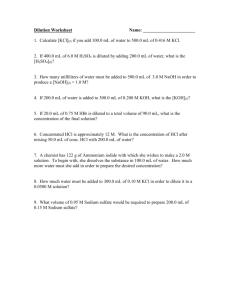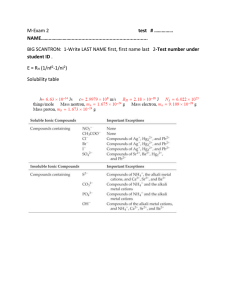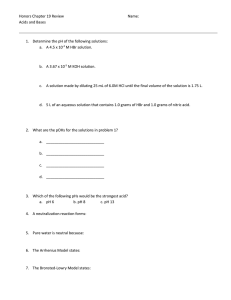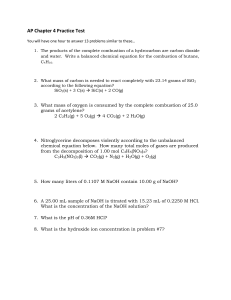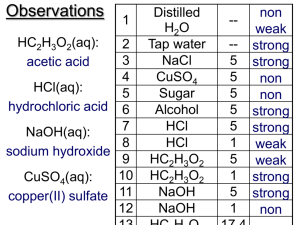Honors Chemistry Name_______________________________
advertisement
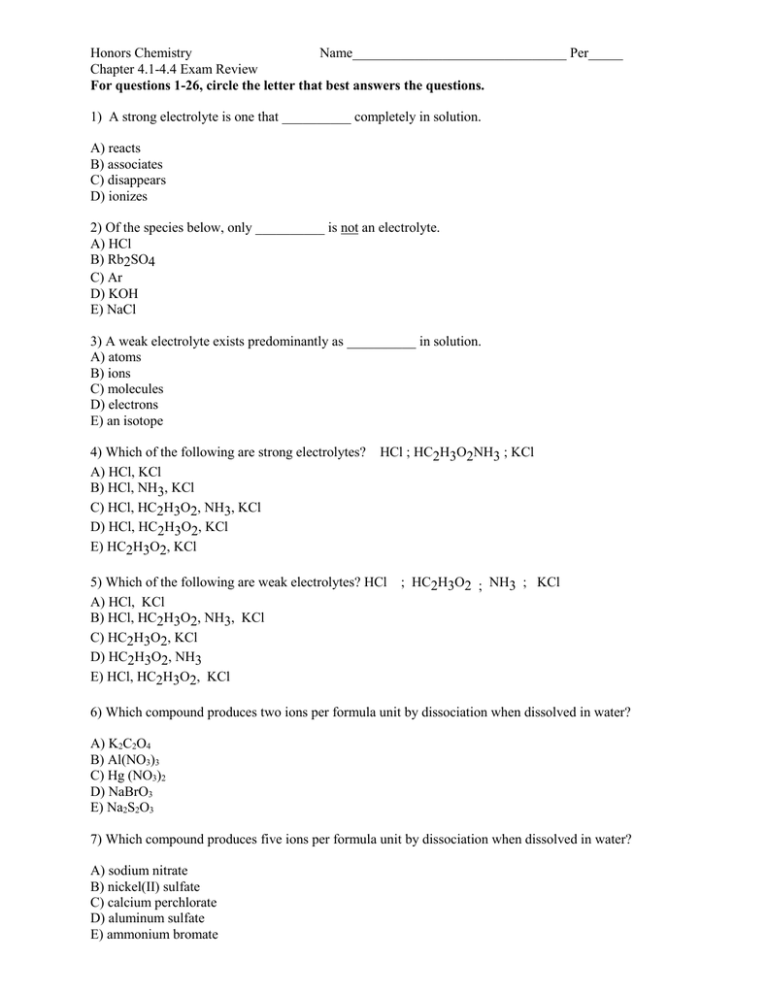
Honors Chemistry Name_______________________________ Per_____ Chapter 4.1-4.4 Exam Review For questions 1-26, circle the letter that best answers the questions. 1) A strong electrolyte is one that __________ completely in solution. A) reacts B) associates C) disappears D) ionizes 2) Of the species below, only __________ is not an electrolyte. A) HCl B) Rb2SO4 C) Ar D) KOH E) NaCl 3) A weak electrolyte exists predominantly as __________ in solution. A) atoms B) ions C) molecules D) electrons E) an isotope 4) Which of the following are strong electrolytes? A) HCl, KCl B) HCl, NH3, KCl C) HCl, HC2H3O2, NH3, KCl D) HCl, HC2H3O2, KCl E) HC2H3O2, KCl HCl ; HC2H3O2NH3 ; KCl 5) Which of the following are weak electrolytes? HCl A) HCl, KCl B) HCl, HC2H3O2, NH3, KCl C) HC2H3O2, KCl D) HC2H3O2, NH3 E) HCl, HC2H3O2, KCl ; HC2H3O2 ; NH3 ; KCl 6) Which compound produces two ions per formula unit by dissociation when dissolved in water? A) K2C2O4 B) Al(NO3)3 C) Hg (NO3)2 D) NaBrO3 E) Na2S2O3 7) Which compound produces five ions per formula unit by dissociation when dissolved in water? A) sodium nitrate B) nickel(II) sulfate C) calcium perchlorate D) aluminum sulfate E) ammonium bromate 8) Which of the following are strong acids? HI ; HNO3 ; HF ; HBr A) HF, HBr B) HI, HNO3, HF, HBr C) HI, HF, HBr D) HNO3, HF, HBr E) HI, HNO3, HBr 9) Which hydroxides are strong bases? Sr (OH)2 ; KOH ; NaOH ; Ba(OH)2 A) KOH, Ba(OH)2 B) KOH, NaOH C) KOH, NaOH, Ba(OH)2 D) Sr)OH)2, KOH, NaOH, Ba(OH)2 E) None of these is a strong base. 10) A neutralization reaction between an acid and a metal hydroxide produces __________. A) water and a salt B) hydrogen gas C) oxygen gas D) sodium hydroxide E) ammonia 11) Combining aqueous solutions of BaI2 and Na2SO4 affords a precipitate of BaSO4. Which ion(s) is/are spectator ions in the reaction? A) Ba2+ only B) Na+ only C) Ba2+ and SO42D) Na+ and IE) SO42- and I12) When aqueous solutions of AgNO3 and NaCl are mixed, AgCl precipitates. The balanced net ionic equation is __________. A) Ag+ (aq) + Cl- (aq) → AgCl (s) B) Ag+ (aq) + NO3- (aq) → AgNO3 (s) C) Ag+ (aq) + NO3- (aq) → AgNO (aq) D) AgNO3 (aq) + NaCl (aq) → AgCl (s) + NaNO3 (aq) E) AgNO3 (aq) + NaCl (aq) → AgCl (aq) + NaNO3 (s) 13) When H2SO4 is neutralized by NaOH in aqueous solution, the net ionic equation is __________. A) SO42- (aq) + 2Na+ (aq) → Na2SO4 (aq) B) SO42- (aq) + 2Na+ (aq) → Na2SO4 (s) C) H+ (aq) + OH- (aq) → H2O (l) D) H2SO4 (aq) + 2OH- (aq) → 2 H2O (l) + SO42- (aq) E) 2H+ (aq) + 2NaOH (aq) → 2 H2O (l) + 2Na+ (aq) 14) The net ionic equation for the dissolution of zinc metal in aqueous hydrobromic acid is __________. A) Zn (s) + 2Br- (aq) → ZnBr2 (aq) B) Zn (s) + 2HBr (aq) → ZnBr2 (aq) + 2H+ (aq) C) Zn (s) + 2HBr (aq) → ZnBr2 (s) + 2H+ (aq) D) Zn (s) + 2H+ (aq) → Zn2+ (aq) + H2 (g) E) 2Zn (s) + H+ (aq) → 2Zn2+ (aq) + H2 (g) 15) Which of the following is soluble in water at 25 °C? A) Fe3 (PO4)2 B) Fe(OH)2 C) Fe(NO3)2 D) FeCO3 E) FeS 16) Which of the following is insoluble in water at 25 °C? A) Mg3(PO4)2 B) Na2S C) (NH4)2CO3 D) Ca(OH)2 E) Ba(C2H3O2)2 17) Which one of the following compounds is insoluble in water? A) Na2CO3 B) K2SO4 C) Fe(NO3)3 D) ZnS E) AgNO3 18) Separate samples of a solution of an unknown salt are treated with dilute solutions of HCl, H2SO4, and NaOH. A precipitate forms in all three cases. Which of the following cations could the solution contain: A) K+ B) Ag+ C) Ba2+ D) Na+ E) None of the above 19) Oxidation is the __________ and reduction is the __________. A) gain of oxygen, loss of electrons B) loss of oxygen, gain of electrons C) loss of electrons, gain of electrons D) gain of oxygen, loss of mass E) gain of electrons, loss of electrons 20) In which species does nitrogen have the highest oxidation number? A) N2 B) NH3 C) HNO2 D) NO2E) NaNO3 21) What is the oxidation number of chlorine in HClO4? A) -1 B) +3 C) +5 D) +7 E) +9 22) Of the choices below, which would be the best for the lining of a tank intended for use in storage of hydrochloric acid? A) copper B) zinc C) nickel D) iron E) tin 23) Of the reactions below, only __________ is not spontaneous. A) Mg (s) + 2HCl (aq) → MgCl2 (aq) + H2 (g) B) 2Ag (s) + 2HNO3 (aq) → 2AgNO3 (aq) + H2 (g) C) 2Ni (s) + H2SO4 (aq) → Ni2SO4 (aq) + H2 (g) D) 2Al (s) + 6HBr (aq) → 2AlBr3 (aq) + 3 H2 (g) E) Zn (s) + 2HI (aq) → ZnI2 (aq) + H2 (g) 24) In the following reaction, which substance is being oxidized? 3 Li(s) + AuCl3(aq) 3LiCl(aq) + Au(s) A) Au B) Li C) Cl D) H2O 25) Given that the Activity Series is: Na>Mg>Cu>Ag>Au, which one of the following answers represents the ions that would not be displaced from aqueous solution (reduced) by metallic magnesium? A) Na+ B) Cu2+ C) Cu2+ and Au+ D) Cu2+, Ag+ and Au+ E) Na+, Cu2+, Ag+ and Au+ 26) Which of the following is an oxidation-reduction reaction? A) Cu (s) + 2AgNO3 (aq) → 2Ag (s) + Cu(NO3)2 (aq) B) HCl (aq) + NaOH (aq) → H2O (l) + NaCl (aq) C) AgNO3 (aq) + HCl (aq) → AgCl (s) + HNO3 (aq) D) Ba(C2H3O2)2 (aq) + Na2SO4 (aq) → BaSO4 (s) + 2NaC2H3O2 (aq) E) H2CO3 (aq) + Ca(NO3)2 (aq) → 2HNO3 (aq) + CaCO3 (s)
